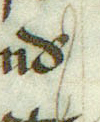|
| A |
 | Usage: Whan
a typical lower case 'a' which are all double compartment graphs. Upper and lower compartments are separated by a horizontal stroke with the upper compartment being completed by an oblique hairline. |  | Usage: And
the scribe might perhaps be identifiable by the number and variety of his upper case 'A's. There must be at least eight variants of this graph on this single folio. |
 | Usage: And
a second example of the upper case graph. This shape is probably most frequently used. |  | Usage: And
yet another version. |
|
| D |
 | Usage: dryueth
'd' in initial position. |  | Usage: and
'd' in final position frequently has a small loop to the right of the shaft. Here it also has a long ascending, then descending hairline extra. |
 | Usage: medicyn
'd' in medial position in a word with down-stroke extending back over the previous graph. |  | Usage: drie
the only example of looped 'd' on this folio. A good example of the fact that the scribe has other versions of single graphs in his repertoire. |
|
| G |
 | Usage: groweth
tailed 'g' in initial position, with horizontal cross-bar to join to the next graph. |  | Usage: among
'g' as the final letter. The formation of this 'g' is the same as version 1. The horizontal cross=bar has a slight downward tag to finish. |
 | Usage: bagges
a perfect example of double 'g'. |  | Usage: droppyng
occasionally the scribe closes the lower compartment. |
|
| H |
 | Usage: herbes
the shaft of 'h' is always upright. The stroke from the shoulder begins with a thick stroke which tapers evenly in downward curve to a hairline finish. |  | Usage: therof
'h' within a word. The scribe's graphs are very evenly formed. |
 | Usage: strength
with the 'th' combination at the end of a word the 'h' is almost always crossed. |  | Usage: lightly
in the 'ght' combination, the 'h' is always crossed even in the middle of a word. |
|
| R |
 | Usage: roote
modern 'r' in initial position. The scribe uses both 'z'-shaped 'r' and modern 'r' in initial, medial and final positions. The occurrence of both graphs appear to be randomly selected although 'z'-shaped 'r' is usual after 'o'. |  | Usage: roted
'z'-shaped 'r' in initial position. |
 | Usage: moder
modern 'r' in final position with flourish. |  | Usage: Ruta
upper case 'R' in a script used for headings. |
|
| S |
 | Usage: springeth
long 's' to begin a word. |  | Usage: bowes
an angular version of '8'-shaped 's' as the final graph. |
 | Usage: is
a very odd graph of 's' which occurs here at the end of a line. The scribe has some idiosyncratic forms for his graphs which he throws in occasionally, although his hand mostly conforms to a learned and almost perfectly reproduced set of graphs. |  | Usage: Some
upper case graph. |
|
| W |
 | Usage: wonderly
'w' in initial position. |  | Usage: now
'w' in final position. |
 | Usage: wt
the scribe's abbreviation for 'with'. Occasionally when 'w' is in initial position there is a lead-in stroke which has the effect of shortening the left arm. |  | Usage: rawe
an odd appearance for this word but demonstrating the 'w' within a word. |
|
| Y |
 | Usage: leuys
the most typical 'y' graph with angled tail with little or no return. The graph also has a stroke above which is equivalent to the dotted 'y'. |  | Usage: Ioyned |
 | Usage: dryueth
occasionally, the scribe curls round the tail of 'y' in a counter-clockwise direction. |  | Usage: echyng
another example of curled-tail 'y'. |
|
| Thorn |
 | Usage: þe
the scribe appears to use thorn as a tool to allow him to organise the length of his line. |  | Usage: þt
the scribe can place the abbreviated letter either above or alongside the thorn graph. |
 | Usage: þe |  | Usage: þ(er)of
'er' abbreviation. |
|
| Abbreviations |
 | Usage: humo(ur)
'ur' abbreviation appearing almost as a 'z'-shaped 'r' above the final graph. |  | Usage: p(ur)geth
same abbreviation. |
 | Usage: seedy(s)
the plural 's' copied above the final graph. The scribe adopts this method frequently to mark the plural. |  | Usage: cont(ra)rie
contraction for 'ra'. Interestingly a different spelling for this word occurs on the same line line with different spelling (cont(ra)ry) but with the same contraction. |










































